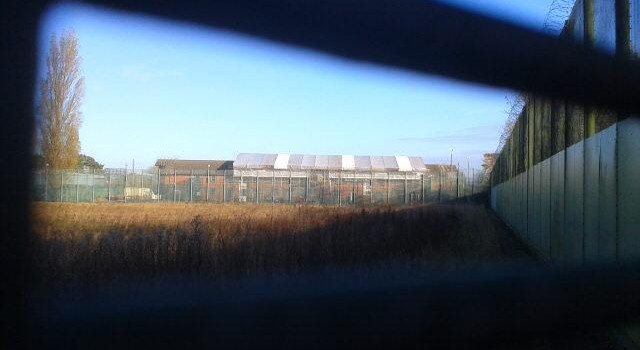Campaigners commemorate 20 years of resistance at Campsfield detention centre

[responsivevoice_button]
Almost 200 people gathered outside Campsfield ‘House’ Immigration Removal Centre in Kiddlington, Oxfordshire, on Saturday 30 November 2013, to demand its closure after twenty years of repression and resistance at the controversial site. Campsfield is not a house but a prison, where asylum-seekers and other migrants are held indefinitely pending deportation. It is run for the Home Office by a private company, Mitie.
Almost 200 people gathered outside Campsfield ‘House’ Immigration Removal Centre in Kiddlington, Oxfordshire, on Saturday 30 November 2013, to demand its closure after twenty years of repression and resistance at the controversial site. Campsfield is not a house but a prison, where asylum-seekers and other migrants are held indefinitely pending deportation. It is run for the Home Office by a private company, Mitie.
Mitie is a FTSE 250 firm which specialises in outsourcing. Its business involves a baffling array of subcontracts; baggage screening at airports, repairing homes for local councils or operating their CCTV, security guards at arms factories and the UK’s second largest oil refinery, cleaners at Sellafield nuclear power plant and Odeon cinemas, checking criminal records, even operating a fleet of snow ploughs. Mitie’s ‘Care and Custody’ division manages courts, prisons and Campsfield House.
Mitie claim to be experts in fire safety systems, having installed sprinklers for the London Underground. It even says on their website “Don’t entrust such a critical system to anyone else”. But six weeks ago, a fire engulfed the main block at Campsfield, collapsing the roof and hospitalising two people. It turned out Campsfield had no sprinklers, despite previous warnings from the Fire Brigade. That wing is still out of action, although repair work on the roof appears to be under way (see photo). One detainee, Farid Pardiaz, 24, is remanded in custody charged with arson. At a hearing in Oxford Crown Court, Farid said “his brain didn’t work” when he set fire to parts of his cell in an apparent suicide attempt. Mitie have not commented on the incident, instead outsourcing any media enquiries to the Home Office.
The fire caused the evacuation of over half the detainees to other detention centres and prisons. On the night of the fire, Corporate Watch interviewed a detainee about the incident, which was picked up by local and national media. In a sinister sequence of events, the detainee claims he was then targeted for retribution by the guards. Complaints about his treatment are being pursued.
Learning from history
Campsfield opened in 1993, as one of Britain’s first migrant jails. It was met with resistance ever since – as veteran campaigner Bill MacKeith of the indefatigable Campaign to Close Campsfield describes here. This 1999 article from our archives shows a familiar pattern of behaviour between the private contractors (then Group 4) and the Home Office.
The campaign’s slogan, “20 years too long”, might sound depressing at first. However, their stamina has no doubt deterred the Home Office from building more detention centres in Oxfordshire. And the campaign’s two decades of struggle is an invaluable resource for communities elsewhere looking to oppose immigration detention. In the evening, the campaign screened Ken Fero’s 1994 film, Tasting Freedom, about a wave of hunger-strikes by detainees in places like Campsfield, Harmondsworth and Pentonville – it is just as relevant today, particularly after the case of Isa Muazu.
A new film about Campsfield is under production – the trailer is available to watch here.
